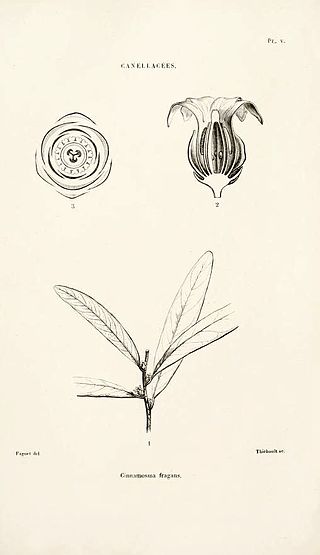
The Madagascar subhumid forests are a tropical moist broadleaf forest ecoregion that covers most of the Central Highlands of the island of Madagascar. They are included in the WWF's Global 200 list of outstanding ecoregions. Most of the original habitats have been lost due to human pressure.

Spondias is a genus of flowering plants in the cashew family, Anacardiaceae. The genus consists of 17 described species, 7 of which are native to the Neotropics and about 10 are native to tropical Asia. They are commonly named hog plums, Spanish plums, libas in Bikol and in some cases golden apples for their brightly colored fruit which resemble an apple or small plum at a casual glance. They are only distantly related to apple and plum trees, however. A more unequivocal common name is mombins.
Appert's tetraka formerly known as Appert's greenbul is a small passerine bird endemic to the south-west of Madagascar. The species was only described in 1972, and has been the subject of considerable taxonomic confusion. It was initially placed in the greenbul genus Phyllastrephus, and later with the Old World warblers in the genus Bernieria. Recent research indicates it is part of an endemic Malagasy radiation currently known as the Malagasy warblers.
Dalbergia hirticalyx is a species of legume in the family Fabaceae. It is found only in Madagascar. It is threatened by habitat loss.
Carlephyton madagascariense is a plant species in the genus Carlephyton endemic to Madagascar.

Zombitse-Vohibasia is a national park in the Atsimo-Andrefana region of south-west Madagascar. It is 147 kilometres (91 mi) north-east of the town of Toliara on the National road 7.
Brenierea insignis is a species of flowering plants in the legume family, Fabaceae. It belongs to the subfamily Cercidoideae and is the only member of the genus Brenierea. It is endemic to Madagascar.
Chapelieria is a monotypic genus of flowering plants in the family Rubiaceae. The genus contains only one species, viz. Chapelieria madagascariensis, which is endemic to Madagascar.

Cinnamosma fragrans is a species of flowering plant in the family Canellaceae. It is endemic to Madagascar, where it is commonly known as saro.
Faguetia is a monotypic genus of trees in the subfamily Anacardioideae of the cashew and sumac family Anacardiaceae. It contains the single species Faguetia falcata, which is endemic to eastern Madagascar.

Quercus castanea is a species of oak tree. It is widespread across much of Mexico, from Sonora to Chiapas, and in Guatemala, El Salvador, and Honduras.
Canarium elegans is a species of tree in the family Burseraceae. It is native to Madagascar.
Capitanopsis magentea is a species of flowering plant in the family Lamiaceae. It is native to northern Madagascar.

Henonia is a monotypic genus of flowering plants belonging to the family Amaranthaceae. It only contains one species, Henonia scopariaMoq.
Salvadoropsis is a monotypic genus of flowering plants belonging to the family Celastraceae. It only contains one known species, Salvadoropsis arenicolaH.Perrier
Poupartiopsis is a monotypic genus of flowering plants belonging to the family Anacardiaceae. The only species is Poupartiopsis spondiocarpus.
Ephippiandra perrieri is a species of flowering plant endemic to the Northern Highlands of Madagascar.
Ephippiandra tsaratanensis is a species of flowering plant endemic to the Tsaratanana Massif of northern Madagascar.
Analavelona, also known as Analavelona Massif, is a mountain in southwestern Madagascar. The massif is home to an enclave of montane subhumid forest, which is considered a sacred forest by the local people and notable for its biodiversity.
Hafotra superba is a species of flowering plant in the family Malvaceae. It is the sole member of genus Hafotra. It is a shrub or small tree endemic to central Madagascar. It grows 3 to 4 meters tall.






